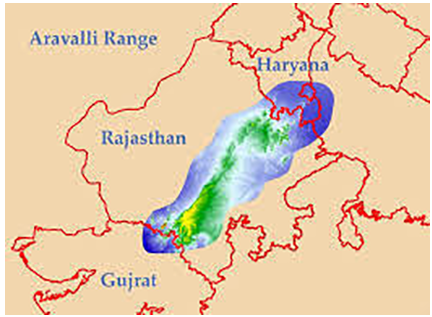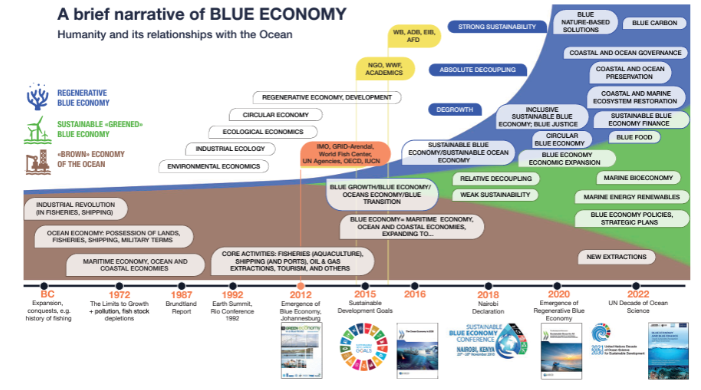10 Jun to 24 Jun, 2024
UNDERSTANDING THE INDIAN OCEAN
Why in news : The Indian Ocean has been getting a lot of attention recently for its rapid warming and the outsized influence it continues to have on its peers.
About :
The Indian Ocean is the third-largest ocean, bounded by Asia to the north, Africa to the west, Australia to the east, and the Southern Ocean to the south.
Unique features
- Monsoon System: The Indian Ocean is uniquely influenced by the monsoon wind system, which affects the climate of the surrounding regions like India, Sri Lanka, and Bangladesh.
- Warmest Ocean: Sea surface temperatures averaging higher than those in the Atlantic and Pacific Oceans.
- Limited Marginal Seas: Unlike other oceans, the Indian Ocean has fewer marginal seas. The prominent ones include the Arabian Sea, the Bay of Bengal, and the Andaman Sea.
- Vital Shipping Routes: The Indian Ocean hosts some of the world's most critical shipping routes, including the Strait of Hormuz, the Strait of Malacca, and the Suez Canal.
- Significant Tectonic Activity: The ocean floor of the Indian Ocean is characterized by active tectonic plate boundaries, including the mid-ocean ridges like the Central Indian Ridge and the Southeast Indian Ridge. These areas are prone to seismic activity, including earthquakes and tsunamis.
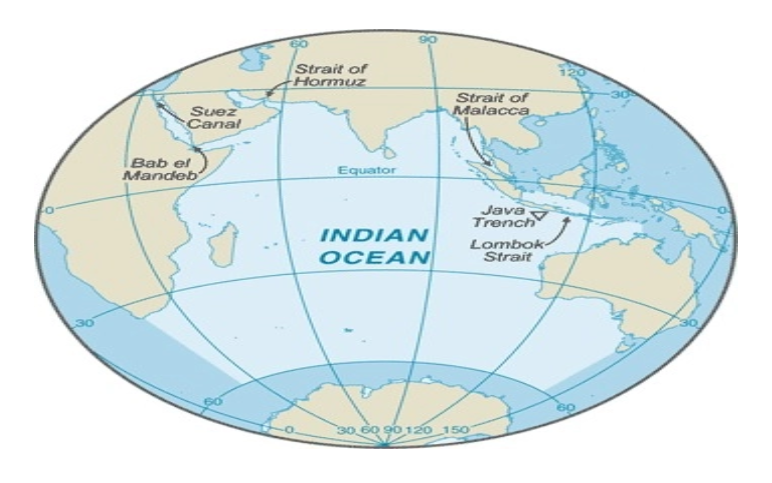
Importance of Indian Ocean
- Trade and Transport: The Suez Canal, connecting the Indian Ocean to the Mediterranean Sea, is one of the world's busiest and most important shipping lanes, handling over 10% of global trade.
- Economic Resources: The Indian Ocean fisheries contribute significantly to global seafood production, with the Western Indian Ocean alone yielding over 11 million tons of fish annually
- Climate Regulation: The Indian Ocean Dipole (IOD), a climate phenomenon in the Indian Ocean, affects rainfall patterns in East Africa, the Indian subcontinent, and Australia, impacting agriculture and water resources.
- Strategic Importance: Several major naval powers, including the United States, China, India, and France, maintain a presence in the Indian Ocean to protect their interests and ensure maritime security.
- Cultural Exchange: The Swahili Coast, along the eastern shores of Africa, developed a unique culture blending African, Arab, Persian, and Indian influences, illustrating the region's rich cultural heritage
Factors Leading to Indian Ocean's High Vulnerability to Heat and Climate Change
- Shallow Basin: The Indian Ocean is relatively shallow compared to other oceans, especially in its northern reaches. Shallow waters heat up more quickly and can also cool down rapidly, leading to higher temperature fluctuations .
- Monsoon Dynamics: The Indian Ocean is strongly influenced by the seasonal monsoon winds, which can lead to large variations in sea surface temperatures. The interaction between the monsoons and ocean currents can create conditions favorable for heat accumulation
- Ocean Circulation: The Indian Ocean has complex circulation patterns, including the Indian Ocean Dipole (IOD) and the Somali Current, which can influence temperature distribution. Changes in these circulation patterns can result in heat anomalies.
- Sea Level Rise: Along with thermal expansion, the melting of ice caps and glaciers due to global warming contributes to sea level rise. The Indian Ocean region is particularly vulnerable to sea level rise, with low-lying coastal areas at risk of inundation.
- Regional Climate Variability: The Indian Ocean exhibits large-scale climate variability, such as the Indian Ocean Dipole (IOD) and the El Niño Southern Oscillation (ENSO), which can influence temperature patterns and weather extremes in the region.
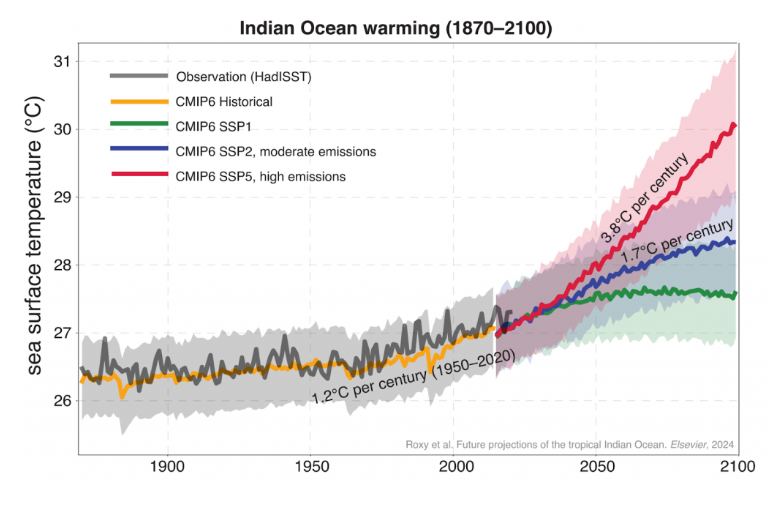
Impacts of Warming Indian Ocean
- Accelerated Sea Level Rise: The Maldives, an island nation in the Indian Ocean, is particularly vulnerable to sea level rise, with some islands already experiencing inundation and erosion.
- Coral Reef Destruction: The Great Barrier Reef, located in the Indian Ocean region, has experienced several mass coral bleaching events in recent years, leading to widespread coral mortality.
- Changes in Marine Ecosystems: The decline of the Indian Ocean's tuna populations due to warming waters has affected fisheries and fishing communities across the region.
- Impact on Fisheries: In Sri Lanka, warming waters have affected the availability of fish stocks, leading to reduced catches and income for local fishermen.
- Intensification of Extreme Weather Events: Cyclone Idai, which struck Mozambique, Zimbabwe, and Malawi in 2019, was one of the strongest tropical cyclones ever recorded in the Indian Ocean, causing widespread devastation.
- Disruption of Monsoon Patterns: The 2019 Indian monsoon season, which saw erratic rainfall patterns and widespread flooding in several states, was attributed in part to the positive phase of the IOD.
- Loss of Coastal Habitats: The Sundarbans, the largest mangrove forest in the world located in the Indian Ocean region, is experiencing rapid deforestation due to a combination of sea level rise, increased salinity, and human activities.
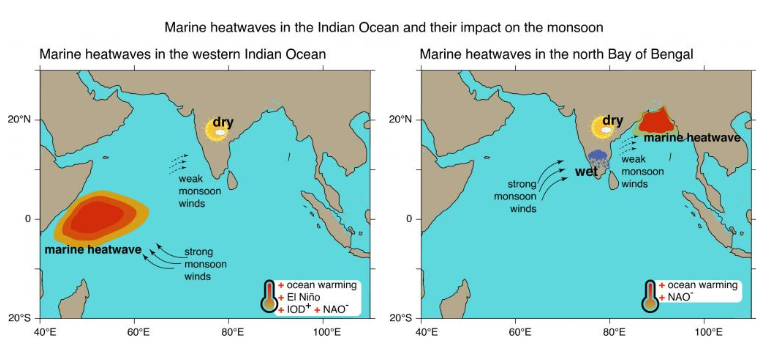
Global Initiatives
- UN Decade of Ocean Science for Sustainable Development (2021-2030): The UN Decade aims to boost international cooperation in ocean science to improve understanding of the ocean-climate nexus and inform policy decisions to address climate change impacts on the ocean, including the Indian Ocean.
- International Maritime Organization (IMO): IMO has adopted measures to reduce greenhouse gas emissions from shipping, including the Energy Efficiency Existing Ship Index (EEXI) and the Carbon Intensity Indicator (CII), which aim to improve the energy efficiency of ships and reduce their carbon footprint in the Indian Ocean and beyond.
- Indian Ocean Commission (IOC): The IOC, an intergovernmental organization of countries in the western Indian Ocean region, works on sustainable development and environmental protection in the region. It collaborates with partners to address climate change impacts on the Indian Ocean.
- Global Climate Fund (GCF): Projects funded by the GCF in the Indian Ocean region focus on renewable energy, coastal resilience, and marine conservation.
India Specific Initiatives
- Indian Ocean Rim Association (IORA): India is a member of IORA, a regional forum promoting sustainable development and cooperation in the Indian Ocean region.
- Coral Reef Conservation Program: India has a Coral Reef Conservation Program that focuses on conservation and management of coral reefs, including efforts to reduce stressors such as pollution and overfishing that can exacerbate coral bleaching.
- Ocean Services, Modelling, Applications, Resources and Technology (OSMART) scheme: Launched by the Ministry of Earth Sciences, OSMART aims to harness the Blue Economy potential of India, which includes efforts to understand and mitigate climate change impacts on the Indian Ocean.
Conclusion
The excessive warming of the Indian Ocean presents a multifaceted challenge, with consequences ranging from accelerated sea-level rise to the devastation of coral reefs and marine ecosystems. Urgent global action is imperative to mitigate these impacts and protect coastal communities. This issue underscores the crucial need for sustainable practices and international cooperation. Addressing the warming of the Indian Ocean is not just an environmental imperative but also a critical step towards ensuring the resilience and well-being of coastal regions worldwide.
Source :
Where to use :
Paper I ( Geography Optional ) : Oceanography
Paper II ( Geography Optional ) & Paper I ( General Studies ) : Resources
EARTH’S INNER CORE ROTATION SLOWING DOWN
Why in news : A recent study published in the Journal Nature suggests that Earth’s inner core began slowing its rotation in 2010, potentially altering the length of a day by fractions of a second.
About :
- The Earth's inner core, a solid sphere of iron and nickel, is encased by a liquid outer core of the same metals. This inner core, approximately the size of the moon, lies at the center of our planet.
- According to recent research, the Earth's inner core has been exhibiting a decrease in rotational speed compared to the planet's surface since approximately 2010.
- Scientists have utilized seismic waves generated by earthquakes to construct visual representations of the inner core's motion, as direct observation or exploration of this region is not feasible.
- The slowing of the Earth's inner core is thought to be due to two main factors.
- Firstly, the movement of the liquid iron in the outer core creates a drag on the solid inner core, causing it to slow down.
- Secondly, the dense parts of the rocky mantle above the core exert gravitational pulls on the inner core, further contributing to its slowing speed.
Implications of Slowing down of Earth’s Inner Core
- Impact on Day Length: The slowing of the Earth's inner core could alter the length of a day on Earth by tiny fractions of a second.
- Influence on Geological Processes: The inner core's rotation plays a crucial role in generating Earth's magnetic field, which shields the planet from harmful solar radiation and affects geological processes. Changes in the inner core's rotation could potentially impact Earth's magnetic properties, influencing geomagnetic events and natural conditions on the planet's surface.
- Limited Surface Impact: Currently, there is little evidence to suggest that the inner core's activities significantly affect life on Earth's surface.
- New Insights: This study not only resolves a longstanding scientific debate but also opens up new avenues for understanding the complex dynamics of Earth's interior, with potential implications for Earth's magnetic field and rotational patterns.
Source :
Where to use :
Paper I ( Geography Optional ) : Geomorphology
CLIMATE CHANGE AND WATER SCARCITY IN ANDAMAN ISLANDS
Why in news : The dry season in the Andaman archipelago, located in the northeast Indian Ocean, has been associated with water scarcity.
About :
Water scarcity in Andman and Nicobar Islands have become a regular phenomenon, especially with the onset of dry season .
Reasons
- Seasonal Variability : The dry season spans from January to May, leading to prolonged periods without significant rainfall.
- High Runoff Rates: Steep slopes, low soil permeability, and proximity to the sea result in 75-80% of rainfall running off into the ocean instead of replenishing groundwater.
- Poor Aquifers: The geological structure, particularly in South Andaman and Little Andaman Islands, includes poor-quality aquifers and coralline rocks, making groundwater storage difficult.
- Climate Change: Erratic rainfall patterns and reduced number of rainy days, likely due to climate change and phenomena like El Niño, exacerbate water shortages.
- Infrastructure Issues: Aging and leaking pipelines lead to significant water loss. Limited maintenance and repairs further exacerbate the problem.
- Population Pressure: Increasing population and tourism put additional strain on the limited water resources available.
- Salinity Ingress: In some areas, such as North and Middle Andaman, seawater intrusion into freshwater sources occurs due to low water tables.
- Natural Disasters: Events like the 2004 earthquake and tsunami damaged many water sources, including wells and reservoirs, reducing their effectiveness.
- Limited Water Storage Capacity: The islands have limited facilities for rainwater harvesting and storage, making it difficult to capture and store rainwater for dry periods.
- Government and Policy Challenges: Chronic underinvestment in water infrastructure and lack of comprehensive water management policies contribute to ongoing scarcity issues.
Solutions
- Check Dams and Ponds
- Rainwater Harvesting
- Desalination Plants
- Community Awareness and Involvement
- Disaster Resilient Water systems
Source :
Where to use :
Paper II ( Geography Optional ) : Regional Planning , Islands
Polar Amplification
Polar Amplification : Polar amplification occurs when changes in the Earth's atmosphere lead to more significant temperature variations near the North and South Poles compared to the rest of the world. This phenomenon is gauged against the average global temperature change and is more pronounced at northern latitudes, where it is referred to as Arctic amplification. It takes place when the net radiation balance of the atmosphere is influenced by an increase in greenhouse gasses.
Geo Engineering
Geo Engineering : Geoengineering is a broad term encompassing a range of experimental technologies aimed at deliberately and significantly intervening in Earth's natural systems to counteract the effects of climate change. These technologies are gradually gaining prominence and can be broadly classified into two categories: Solar Radiation Modification (SRM), also known as Radiative Forcing Geoengineering (RFG), and Carbon Dioxide Removal (CDR) technologies.
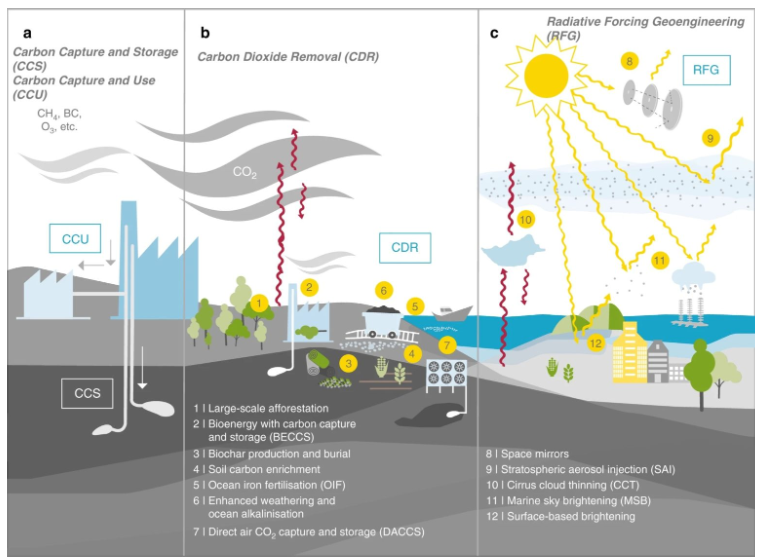
Carbon offsetting
Carbon offsetting : Carbon offsetting is a strategy employed by individuals, companies, and governments to balance their greenhouse gas emissions by financing equivalent carbon savings elsewhere. This typically involves supporting projects that reduce emissions, such as renewable energy development, forest conservation, or reforestation efforts.
Diadromous
Diadromous : Diadromous fish are species that migrate between saltwater and freshwater environments. They travel between the ocean and rivers or streams at various stages of their lives.
Preston Curve
Preston Curve : The Preston curve represents the empirical relationship between a country's life expectancy and its per capita income, as proposed by American sociologist Samuel H. Preston in 1975. The curve demonstrates that individuals in wealthier countries tend to have longer lifespans compared to those in poorer nations, likely due to improved access to healthcare, education, nutrition, and other resources. As the per capita income of a poor country increases, its life expectancy rises significantly in the initial stages.
THREATENED LOWLAND FYNBOS HABITAT
The lowland fynbos, a crucial part of the Cape Fynbos Biome in South Africa, is characterized by its unique plant diversity and high levels of endemism. This habitat, however, is under severe threat due to various anthropogenic pressures.
- It is estimated that less than 10% of the original extent of lowland fynbos remains intact due to agricultural and urban development.
- The lowland fynbos hosts around 1,465 plant species, with approximately 75% of these being endemic.
- Invasive species have been shown to significantly alter fire regimes and reduce water availability, further threatening the remaining lowland fynbos . Eg.Acacia Saligna
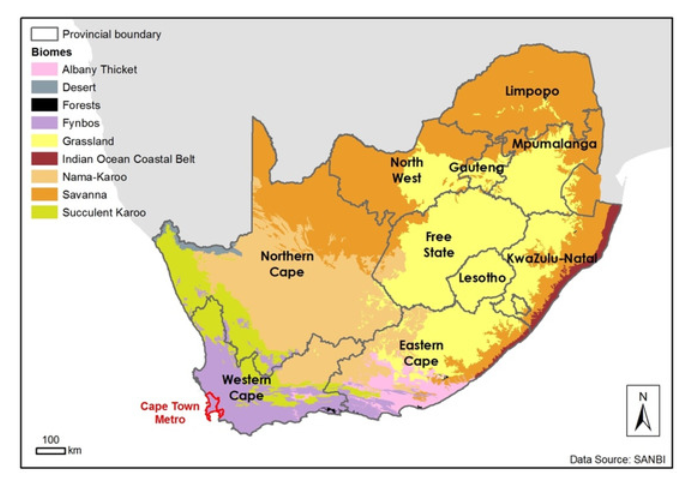
Source :
https://www.bgci.org/files/Wuhan/PapersConserving/Twine.pdf
https://www.sciencedirect.com/science/article/pii/S025462991630206X
Where to use :
Paper II ( Geography Optional ) : Biogeography and Envt Geography
Places in the news
1. Seethakonda Reserve Forest
Why in news : SRF has started acquiring a host of exotic animals including Bengal Fox and Himlayan Black Bear.
- It is located amidst Indira Gandhi Zoological Park in Visakhapatnam district of Andhra Pradesh
- This ex-situ facility is surrounded by the Eastern Ghats and the Bay of Bengal.
- Approx : Visakhapatnam
2. Binsar Wildlife sanctuary
Why in news : The Indian Air Force deployed an MI17 helicopter to control the massive wildfire in Binsar Wildlife Sanctuary (BWS) .
- It is a protected area located in the state of Uttarakhand, India.
- It is situated in the Kumaon region of the Himalayas, approximately 33 kilometres north of the Almora district, Uttarakhand.
- The sanctuary covers an area of around 47 square kilometres.
- Approx : Almora
3. Nagarhole Tiger reserve
Why in news : Mysuru Dasara elephant Ashwatthama dies of electrocution in Nagarhole Tiger Reserve
- Nagarahole Tiger Reserve previously known as Rajiv Gandhi (Nagarahole) National Park, was named after the river ‘Nagarahole’ which literally means ‘Serpent River’ (Nagara=Serpent; Hole=River) in Kannada language
- The reserve forms a critical connecting habitat for tigers and elephants to other areas of Western Ghats through Brahmagiri wildlife sanctuary and to the Eastern Ghats through Bandipur Tiger reserve.
- Approx : Mysore
4. Nakti Bird Sanctuary
Why in news : Nagi and Nakti bird sanctuaries designated ‘Ramsar Sites’ taking country’s recognised wetlands tally to 82
- The Nagi Dam (791 ha) and Nakti Dam (332 ha) are two sanctuaries so close to each other that they can be taken as one bird area. Nagi is 7 km from Jhagha in the district Jamui, and Nakti is a further c. 4 km from Nagi, occupying similar habitat.
- About 1,600 Bar-headed Goose Anser indicus have been recorded from this site
- Approx : Jamui
5. Kakinada
Why in news : Recently Coromandel International opens nano-fertilizer plant in Kakinada
- It is the sixth largest city of the Indian state of Andhra Pradesh and serves as the district headquarters of the Kakinada District.
- It was also the origin point of Buckingham Canal where goods used to be transported by boats during the British rule.
- Kakinada is known for its sweet called Kaja which became a famous recipe in South India known as Kakinada Kaja.
- Approx : Rajahmundry
Fortnightly KOSMOS MCQs Practice
Q1. Consider the following statements regarding the International Union for Conservation of Nature:
- The IUCN is a membership union consisting solely of government organizations.
- The IUCN Red List of Threatened Species is the most comprehensive global inventory of the conservation status of plant and animal species.
Which of the statements given above is/are correct?
- Only 1
- Only 2
- Both 1 and 2
- Neither 1 nor 2
Q2. With reference to the National Disaster Management Authority (NDMA), consider the following statements:
- Under the Disaster Management Act of 2005, the Home Minister serves as the chairperson of the National Disaster Management Authority.
- This apex body formulates policies, plans, and guidelines for disaster management to ensure a timely and effective response to disasters.
Which of the statements given above is/are not correct?
- Only 1
- Only 2
- Both 1 and 2
- Neither 1 nor 2
Q3. Sympatric Speciation , recently in news in related to :
- The formation of new species from geographically isolated populations.
- The formation of new species from a small population isolated at the edge of a larger population
- The formation of new species from a continuously distributed population.
- The formation of new species within the range of the ancestral population.
Q4. Consider the following statements about the Nile River:
- It originates south of the equator in Burundi, Africa.
- It flows through Egypt and 10 other African countries before emptying into the Mediterranean Sea.
- The Nile comprises of two main tributaries, the Blue Nile and the White Nile.
How many of the statements given above are correct?
- Only one
- Only two
- All three
- None
Q5. With reference to National Tiger Conservation Authority (NTCA), consider the following statements:
- Under the Ministry of Environment, Forest, and Climate Change (MoEFCC), it provides statutory authority to Project Tiger.
- It was established under the enabling provisions of the Wildlife (Protection) Act, 1972.
Which of the statements given above is/are correct?
- Only 1
- Only 2
- Both 1 and 2
- Neither 1 nor 2
Q6. Consider the following statements about Asiatic Wild Dogs (Dhole):
- In India, they are exclusively found in the Western Ghats.
- It is listed as Critically Endangered on the IUCN Red List.
- Dholes are highly social animals that often hunt in packs.
How many of the statements given above are correct?
- Only One
- Only Two
- All Three
- None
Q7. Consider the following statements regarding Geoengineering:
- It is a method specifically created to address the impacts of climate change.
- This is typically achieved by either extracting carbon dioxide (CO2) from the atmosphere or reducing the amount of sunlight reaching the Earth's surface.
- Stratospheric Aerosol Injection (SAI) is an example of such geoengineering techniques.
Which of the above statements is/are correct?
- Only one
- Only two
- All Three
- None
Q8. The Greater Tunb, The Lesser Tunb and Abu Musa Island, sometimes seen in the news, are disputed between which of the following?
- Armenia - Azerbaijan
- Israel and Jordan
- Israel and Lebanon
- Iran-UAE
Q9. With reference to Binsar Wildlife sanctuary , consider the following statements :
- The sanctuary is located in the Kumaon Hills of Uttarakhand .
- It was named after the Bineshwar Mahadev temple, a 16th-century temple dedicated to Lord Shiva.
Which of the statements given above is/are correct?
- Only 1
- Only 2
- Both 1 and 2
- Neither 1 nor 2
Q10.Consider the following tribes:
- Shompen
- Onges
- Todas
- Sentinelese
How many of the tribes mentioned above are indigenous to the Andaman and Nicobar Islands?
- Only one
- Only two
- All three
- None
Share the article
Edukemy’s Current Affairs Quiz is published with multiple choice questions for UPSC exams
MCQ
Get Latest Updates on Offers, Event dates, and free Mentorship sessions.

Get in touch with our Expert Academic Counsellors 👋
FAQs
Geography Current Affairs focuses on the contemporary issues, events, and developments in the field of geography. It covers recent geographical phenomena, environmental changes, geopolitical shifts, and related news. This differs from regular geography studies which may focus more on foundational concepts, historical contexts, and theoretical frameworks.
Updates are provided regularly to ensure that subscribers stay informed about the latest developments in geography. Typically, updates are provided on a fortnightly basis, depending on the frequency of significant events and changes in the field.
Absolutely. Geography Current Affairs serves as a valuable resource not only for Geography optional but also for GS papers, especially GS Paper 1 (covering Indian Heritage and Culture, History, and Geography of the World and Society) and GS Paper 3 (covering Technology, Economic Development, Biodiversity, Environment, Security, and Disaster Management). It aids in building a holistic understanding of various topics and strengthens answer-writing skills by incorporating contemporary examples and perspectives.
Geography Current Affairs holds immense importance for UPSC preparation, particularly for aspirants opting for Geography optional. It helps candidates stay updated with the latest developments, geographical phenomena, environmental issues, and geopolitical shifts worldwide, aligning them with the dynamic nature of the subject as tested in the UPSC examinations.


